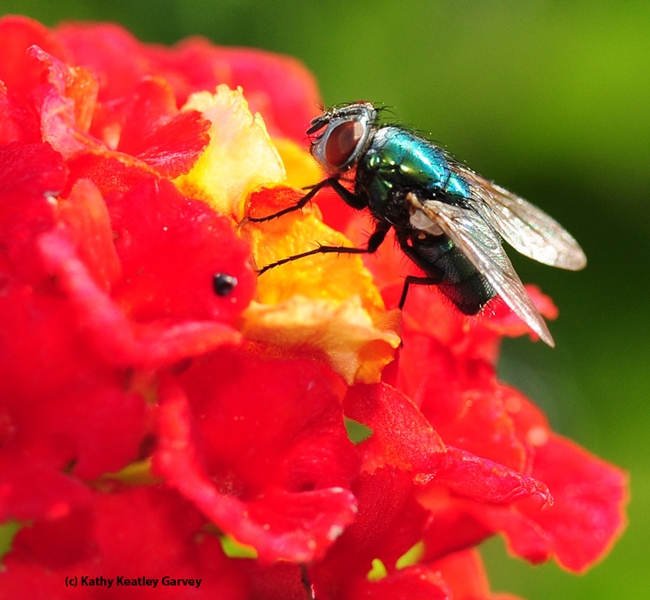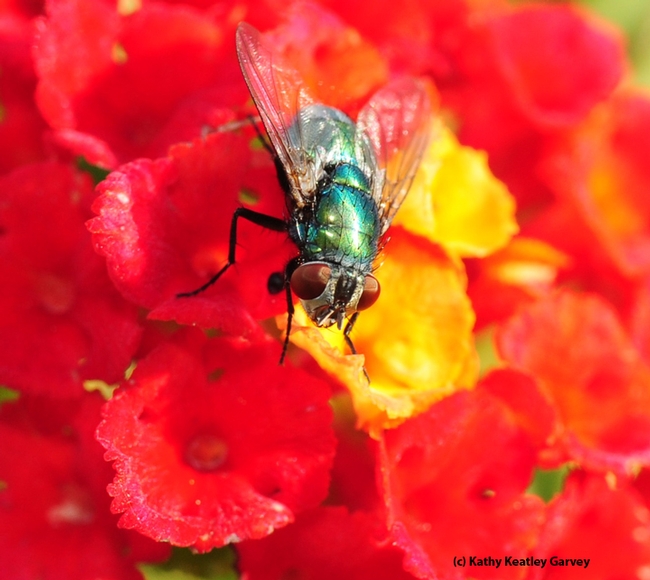- Author: Kathy Keatley Garvey
A green bottle fly lands on a tropical milkweed, Asclepias curassavica, in a Vacaville pollinator garden.
Houston, we have landed!
The fly, Lucilia sericata, begins to sip the nectar, unaware that a hungry praying mantis, a Stagmomantis limbata (as confirmed by mantis expert Lohit Garikipati) is watching.
The mantis slowly sneaks within striking distance, and waits for his prey to approach closer. Closer. Closer. Closer.
Whoosh! Gotcha! It wraps its spiked forelegs around it.
Houston, dinner is served! Fly à la carte.
Want to learn more about praying mantises?
The Bohart Museum of Entomology at UC Davis is hosting an open house, themed "Praying Mantises," on Sunday, Aug. 27 in Room 1124 of the Academic Surge Building, 455 Crocker Lane. It is free and family friendly.
According to Kris Anderson of Las Vegas, an alumnus of Cornell University (master's degree in entomology) and author of Praying Mantises of the United States and Canada: "There are just 28 species of Mantodea found within the United States and Canada, the 7 largest of which are invasive species from other parts of the globe."
Some myths about praying mantises, as related by Anderson in his book, available on Amazon:
Myth: "Mantises sway back and forth while crawling to imitate vegetation blowing in the wind."
Truth: "The peering movement of mantises, demonstrated by the swaying back and forth of their body while ambulating or preparing to leap/take flight, is a behavioral adaptation to gain depth perception of their surroundings and has nothing to do with mimicry. Mantises blend into their environment by remaining motionless against a substrate that they morphologically resemble—not by moving. Peering movements causes the retinal images of nearby objects to be displaced more quickly than those of more distant objects, thus allowing the mantis to gain depth perception of its environment as it navigates forward."
Myth: "Mantises grab insects and immediately bite the neck/head to quickly kill their prey."
Truth: "The spinose forelegs of praying mantises are used to hold onto and prevent their prey from escaping. Once secured in their grip, the mantis will pull the prey forward and begin to meticulously chew upon whatever body part of the prey item is closest to their mouth—be it a leg, a wing, the thorax, abdomen, or head. No specific body region is exclusively targeted and the prey is always eaten alive, bit by bit, dying a slow death."
Myth: "Female mantises cannibalize the males while mating."
Truth: "With over 2,400 species of Mantodea worldwide, only a small fraction of species regularly engage in sexual cannibalism. Most do not. Of those that engage in this practice, the occurrence is not inevitable, as males typically escape and may mate with other partners."
The Bohart Museum, founded in 1946 and directed by UC Davis distinguished professor Lynn Kimsey, houses a global collection of eight million insect specimens, plus a live insect petting zoo (Madagascar hissing cockroaches, stick insects and tarantulas), and an insect-themed gift shop, stocked with t-shirts, hoodies, books, posters, jewelry and more.
The Bohart Museum is planning two other open houses this fall:
Saturday, Sept. 23: Household Vampires
Saturday, Nov. 4: Monarchs
All open houses are free and family friendly. At each event, the focus is on a special theme, but there's also a family arts-and-crafts activity, announced Tabatha Yang, education and outreach coordinator.
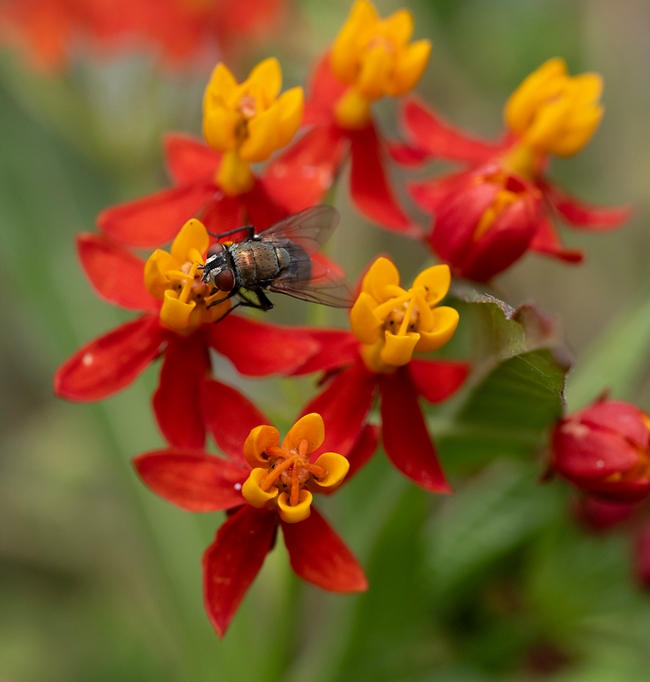
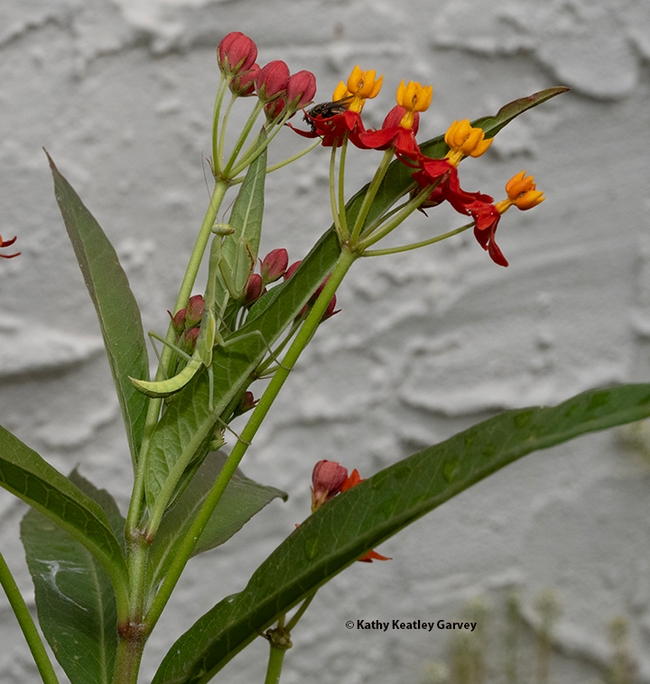
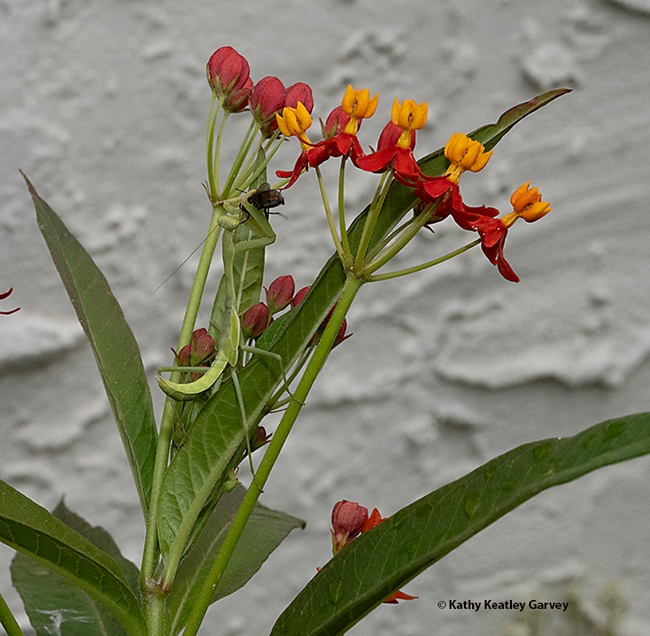
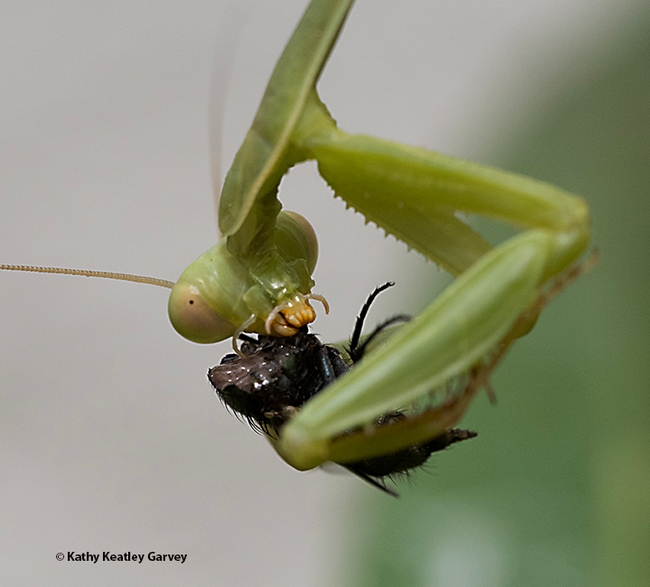
- Author: Kathy Keatley Garvey
Flies seem to be in the news a lot lately.
But have you ever looking closely at a common green bottle fly Lucilia sericata, also known as a blowfly?
Ever admired their brilliant metallic blue-green coloration? Ever thought about them as pollinators (they are sometimes!) but of course, that's not what they're known for.
They're known for their forensic, veterinary and medical importance. They are nature's recyclers when the females deposit their eggs in carrion.
But they're also beautiful.
We captured these photos of a green bottle fly on a tropical milkweed, Asclepias curassavica, in our garden. The red and yellow blossoms contrasted nicely with the stunning fly coloration. Nature's art.
Indeed, flies are an integral part of the annual UC Davis Picnic Day (cancelled this year due to the COVID-19 pandemic and precautions). What's a picnic without flies?
Forensic entomologist Robert "Bob" Kimsey of the UC Davis Department of Entomology and Nematology always staffs a booth at Briggs Hall where he holds forth as "Dr. Death" with his microscope and specimens as he encourages--and fields--questions from the thousands of picnickers. (See Bugs at Briggs)
Also at Briggs Hall during the UC Davis Picnic Day, "Maggot Art," is extremely popular. The artists, mostly children and teens, dip a maggot into water-based, non-toxic paint and drop it onto a white piece of paper and let it crawl. The finished product often finds its way onto a refrigerator, inside a frame, or as as an unexpected gift to grandparents. Certainly it's a conversation piece.
Meanwhile, mark your calendar for April 17, 2021, the scheduled date of the next UC Davis Picnic Day.
Dr. Bob, the flies, and the maggots will be waiting.
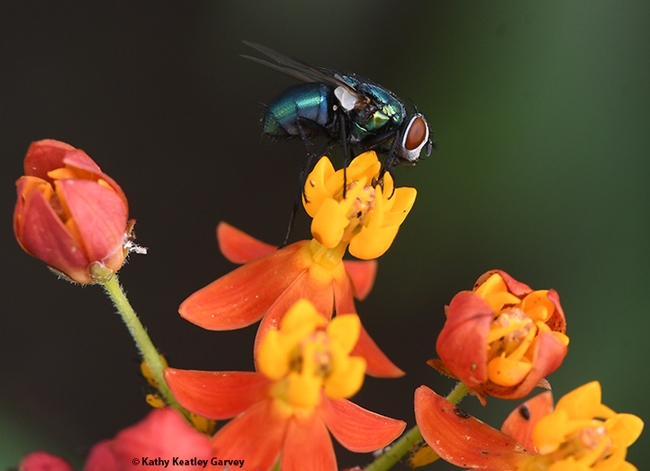
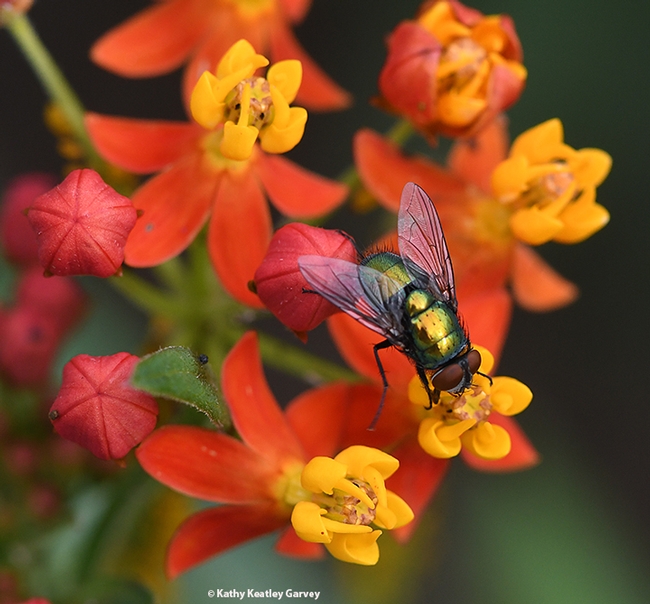
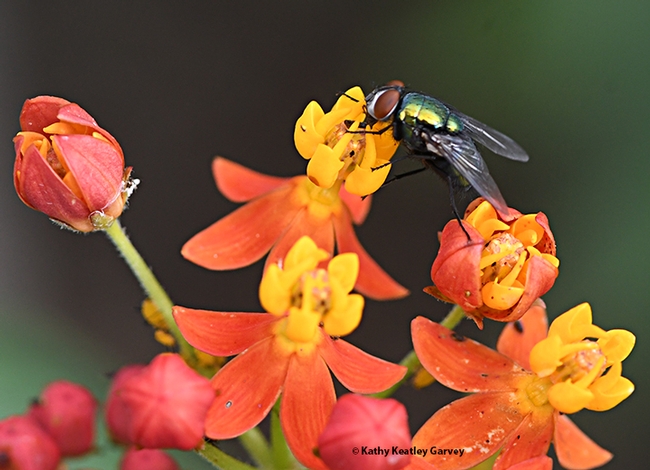
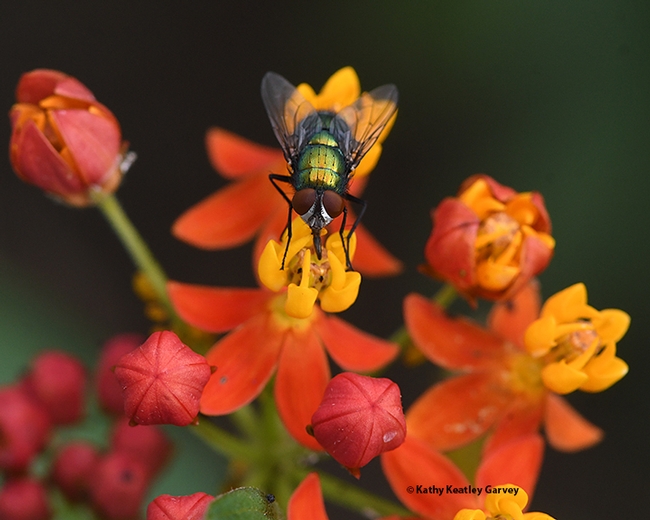
- Author: Kathy Keatley Garvey
What's for dinner?
If you're a praying mantis nymph, Stagmomantis limbata, perched on a sunflower, sometimes it can be a long wait. Breakfast fades into lunch, lunch fades into dinner...
First you scout out your territory and spread out (hey, look at me)!. Then you lurk in the shadows (don't look at me; I am not here)!
Where, oh, where is the prey?
And then it happens. Drama on a sunflower blossom.
This little nymph managed to snag what appeared to be a green bottle fly, or that's what it looked like at the onset. Toward the end it was as unrecognizable as whirled black-eyed peas and pureed ham hocks.
A fly might not be as tasty as a honey bee or a longhorned bee, but dinner is served. Bon Appétit!
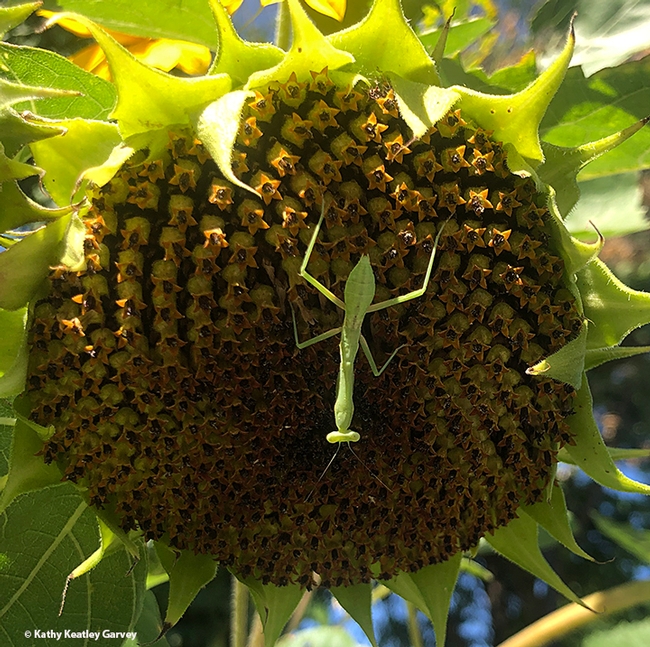
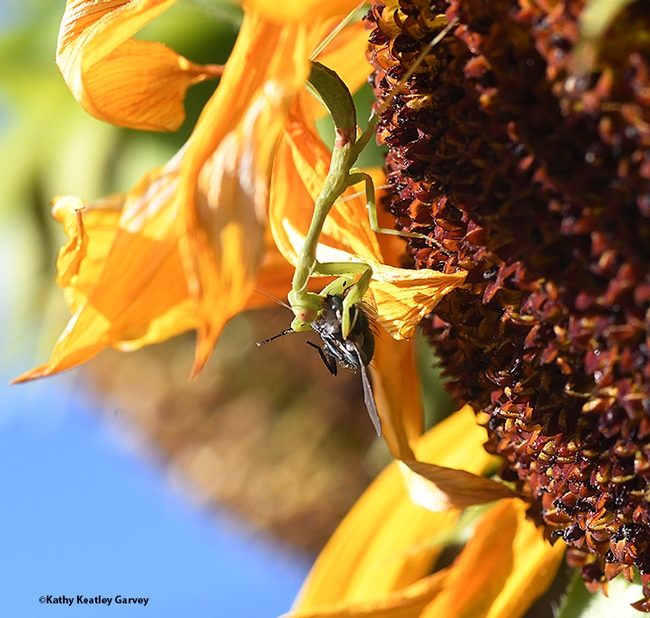
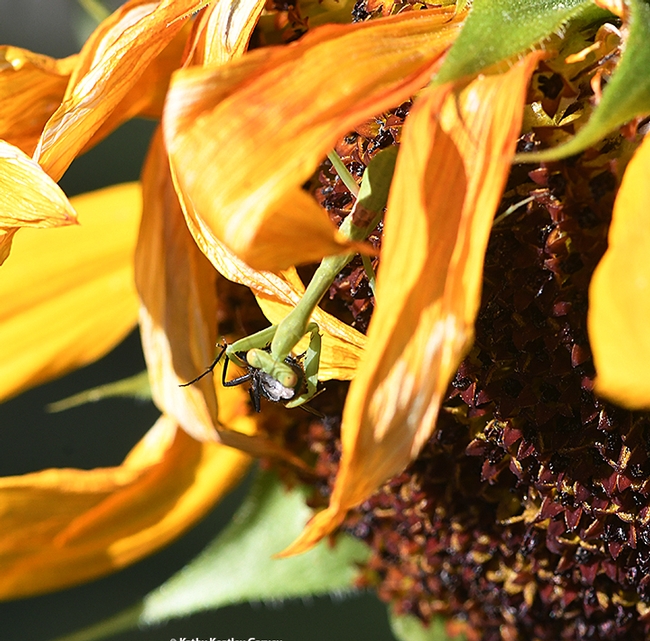
- Author: Kathy Keatley Garvey
What's for dinner?
A crab spider, camouflaged in our lavender patch, didn't catch a honey bee, a butterfly, an ant or a syrphid fly.
No, it nailed a green bottle fly.
We couldn't help but notice. The fly's metallic blue-green coloring stood in sharp contrast to the white spider.
One venomous bite to kill it. And soon the fly, Lucilia sericata, was toast. Milk toast.
Crab spiders don't build webs to trap their prey. They're cunning and agile hunters that spring into action when an unsuspecting prey appears on the scene. They belong to the family Thomisidae, which includes some 175 genera and more than 2100 species. And they're ancient: spiders date back 400 million years ago.
Do you like spiders? You should.
“Spiders are an incredibly diverse group with more than 50,000 species described with probably another 200,000 remaining to yet be discovered,” says spider expert Jason Bond, the Evert and Marion Schlinger Endowed Chair in Insect Systematics in the UC Davis Department of Entomology and Nematology.
It's worth repeating what Professor Bond said about spiders at the Bohart Museum of Entomology open house, “Eight-Legged Wonders,” on Saturday, March 9.
The five good reasons to like spiders:
- Spiders consume 400-800 million tons of prey, mostly insects, each year. Humans consume somewhere around 400 million tons of meat and fish each year.
- Spider silk is one of the strongest naturally occurring materials. Spider silk is stronger than steel, stronger and more stretchy than Kevlar; a pencil thick strand of spider silk could be used to stop a Boeing 747 in flight.
- Some spiders are incredibly fast – able to run up to 70 body lengths per second (10X faster than Usain Bolt).
- Athough nearly all 47,000-plus spider species have venom used to kill their insect prey, very few actually have venom that is harmful to humans.
- Some spiders are really good parents –wolf spider moms carry their young on their backs until they are ready to strike out on their own; female trapdoor spiders keep their broods safe inside their burrows often longer than one year, and some female jumping spiders even nurse their spiderlings with a protein rich substance comparable to milk.

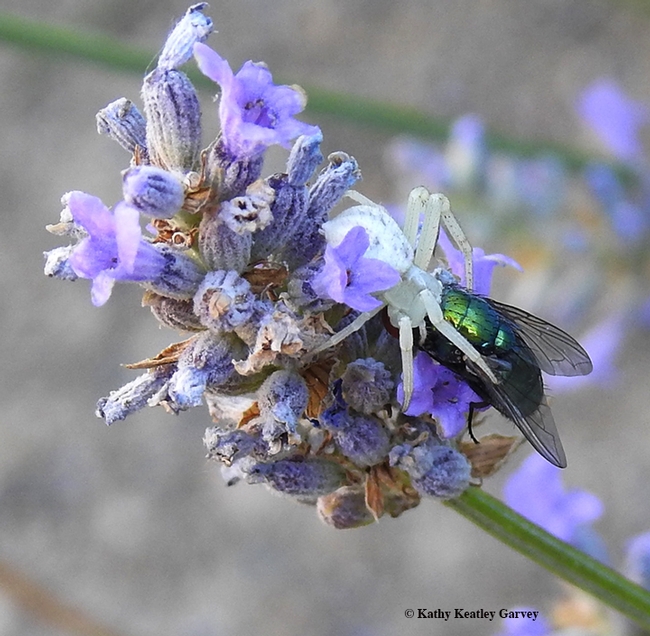
- Author: Kathy Keatley Garvey
Strange thing, nobody ever says "as green as a green bottle fly."
'Cept maybe an entomologist.
You've heard:
- As green as an emerald
- As green as a lizard
- As green as a gourd
- As green as grass
- As green as bottled glass
- As green as it gets
But as "green as a bottle fly" (or blow fly in the family Calliphoridae)?
No. Most people cringe at the very sound. They associate green bottle flies with their larvae, aka maggots, which eat rotting flesh. These insects lay their eggs in cadaver tissue. At crime scenes, forensic entomologists can determine the time of death by examining the developmental stage of the larvae.
And, of course, maggots are used medically in maggot therapy (to consume dead tissue around live tissue).
Then there's Maggot Art, coined by a former UC Davis entomology major, Rebecca O'Flaherty. At the annual UC Davis Picnic Day, children visiting Briggs Hall (home of the UC Davis Department of Entomology and Nematology) engage in Maggot Art, picking up a maggot with forceps, dipping it into non-toxic, water-based paint, and then letting it crawl on a white sheet of paper! Voila! Maggot Art, suitable for framing! (See Bug Squad, "Me and My Maggot." Some of the young artists get quite attached to the maggots and ask their parents if they can take them home. Of course, the answer is "Yes!" (Not!) Want to try Maggot Art? Mark your calendar for April 22, 2017 when the 103rd annual UC Davis Picnic Day takes place.
Green bottle flies can also be beautiful. Have you ever seen an emerald green bottle fly sipping nectar from a red flower, such as Lantana? When the light is just right, this little insect can make you say "Wow!"
Plus, it's a pollinator. It gets a little recognition, but not much, during National Pollinator Week.
